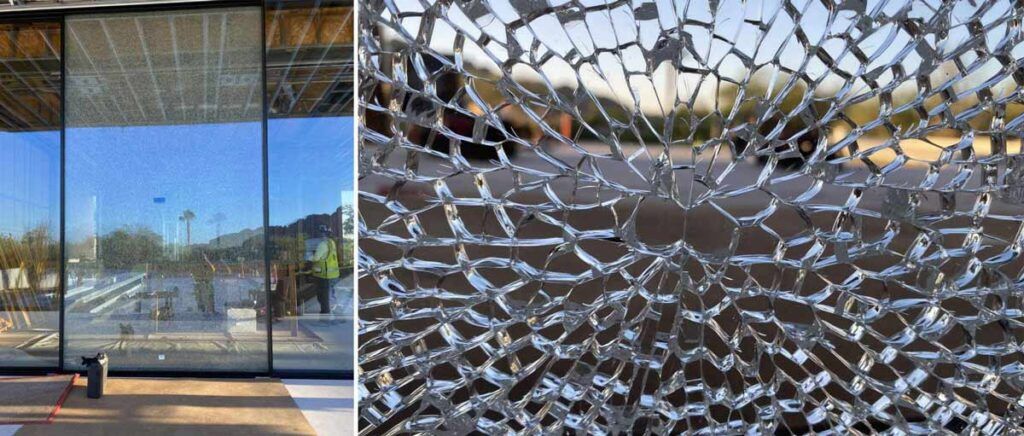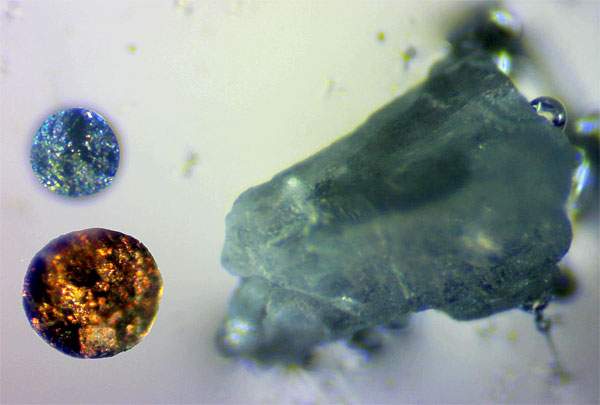The use of fully tempered glass is common in the building and car industries, and for good reason. When tempering is included in the glass manufacturing process, the result is glass that is four to five times stronger than standard annealed glass – giving it the benefits of both durability and safety.
At Giroux Glass, we typically install this type of “safety glass,” (as it’s sometimes referred to), in windows and doors, shower enclosures, storefronts, and other applications. It’s considered safer than other glass because when it breaks, shards don’t fly in all directions and potentially hit people nearby; it stays in position. And although this glass is certainly safer, sometimes safety glass still shatters spontaneously and unexpectedly, with no visible cause.
Spontaneous Breakage
Spontaneous breakage is a rare occurrence and happens for one of two reasons: thermal shock/stress and nickel sulfide inclusion. Recently, this type of spontaneous shattering took place in the home of one of our high-end residential clients. Marty McKinley, our vice president of Arizona operations, checked it out to determine the cause. “After a visual inspection, I was able to locate the cause, and explained to the homeowners that the cause was nickel sulfide inclusion,” he stated. He made this conclusion by eliminating other explanations, and by identifying that the epicenter of the break resembled a “butterfly” pattern, as can be seen in these photos.
The two photos below show views of the home’s broken lite. One photo depicts the entire door, while the other is a close-up showing this very distinct butterfly pattern:

In inspecting the breakage of this one lite, our field observations ruled out other typical possible explanations. Other causes could have been breakage from edge damage due to scratches and nicks, exposure to rapid changes in temperature, or physical damage from a strike with another object. We knew that for nickel sulfide inclusion (NiS) to cause the break, the implosion would center around one singular point on the glass, and fan out in a butterfly wing formation. This lite’s breakage did exhibit that telltale pattern, which helped to confirm our suspicions that nickel sulfide inclusion was indeed the cause.
Causes of Nickel Sulfide Inclusion
What causes this to happen? Nickel sulfide inclusions can occur during the process of manufacturing toughened glass. They result from sulfur that reacts with the presence of minute amounts of nickel contaminants that are contained in the glass. Although they are invisible due to their minuscule size—they range from .05 mm up to .1 mm—they may still be present in manufactured glass. These particles remain benign until they are aggravated.

If NiS is present in the glass, there is a risk that the glass will spontaneously break, if the particle should change its size or shape.
NiS has two main states; stable at high temperatures and stable at lower temperatures. When the glass cools quickly, the NiS particle is unable to change back to its original form. Over a while, NiS will slowly convert to the original low-temperature structure. This causes the NiS particles to increase slowly in size. As a result, stress can cause the pane of glass to shatter for no visible reason. The length of time it can take for this to happen is unpredictable. It can occur within weeks of manufacture, or years — or never.
Glass manufacturers have implemented changes to eliminate NiS from the production of toughened glass. In their attempts to prevent this issue, glass producers have modified their choices of raw materials, manufacturing methods, and processing techniques. Although they’ve succeeded in making some improvements, it’s impossible to eradicate the risk. The fact remains that all glass comes with a very rare risk of spontaneous breakage due to NiS.
What Is Heat Soaking and How Can It Help?
To reduce the risk of a spontaneous NiS breakage, manufacturers include a finishing process called “heat soaking.” In large heat-soaking ovens, they heat glass to a very high temperature, which causes panes containing any amounts of NiS to shatter. The glass that survives the testing has a lower chance of containing NiS, and therefore reduces the risk of spontaneous breakage after its installation. The heat-soaking process does increase both the cost and the time to manufacture the glass, but does reduce the risk of spontaneous NiS breakage. These heat-soaking methods can reduce the risk of NiS breakage taking place from one m2 in every 10,000 m2 of glass, to one m2 in every one million m2 of glass. (Glass and Glazing Federation). This reduction effectively means it will rarely take place.
Due to the impossibility of finding such very small inclusions, glass manufacturers can neither guarantee the complete absence of NiS nor provide a warranty against the possibility of its presence.
Lamination ensures that in the possibility of a break, the glass shards mostly stay in place. In our experience, utilizing material from large domestic manufacturers such as Guardian Glass and Vitro can significantly reduce the chance of spontaneous breakage. Such large manufacturers typically include exceptional quality control systems as a part of their process.
Even though NiS can be one potential reason for spontaneous glass breakage, it’s certainly not the most common. Other reasons, such as damage to a glass edge or to the glass surface, are more likely to be the explanation. Let the pattern of the breakage provide the first clue as to its cause, and know that it truly is an uncommon occurrence.